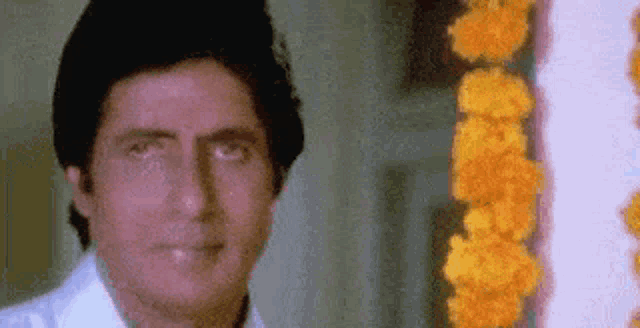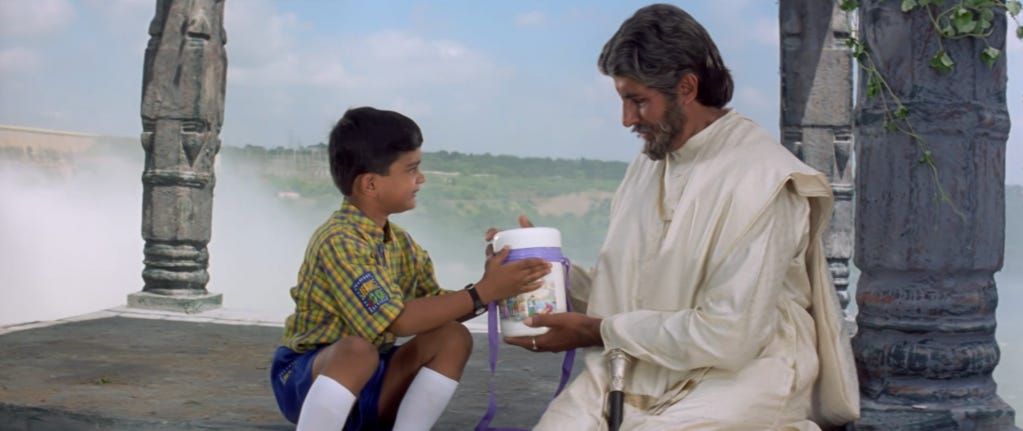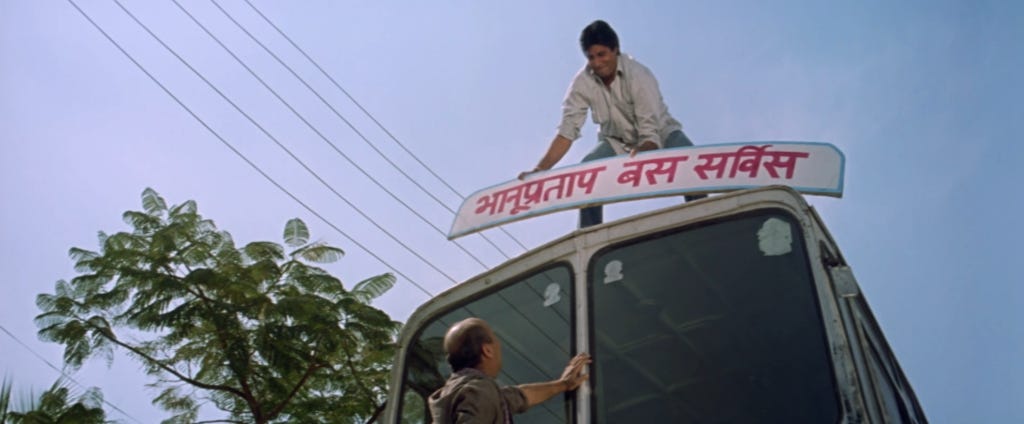Sooryavansham: The OG guilty pleasure watch
Endless reruns made this middling melodrama a family favourite, and the legions of jokes and memes it inspired turned Sooryavansham into an unlikely pop culture staple.
In Hindi cinema, kheer has long been the sacred symbol of a doting mother’s love for her child, often competing with the hot favourite, gaajar ka halwa, for the honour. The humble, harmless dessert was drafted into a lactose-heavy, jingoistic war cry against the enemy in the Sunny Deol-starrer Maa Tujhhe Salaam (2002). But the dessert achieved its moment in the sun when it became an astounding pop-culture prop in EVV Satyanarayana’s Sooryavansham (1999). In the movie, an unsuspecting Thakur Bhanu Pratap Singh (Amitabh Bachchan) consumed “zehreeli kheer,” which resulted in the most dramatic, projectile, bloody vomit in the history of Bollywood.
Sooryavansham has acquired cult status among Bollywood fans, partly due to its perpetual Sunday afternoon telecast on Set Max (now Sony Max). The channel’s inexplicable fixation with this sappy family drama continues to inspire legions of jokes, memes, and even serious reportage. The film—a remake of the Tamil blockbuster Suryavamsam (1997)—cast Bachchan in a double role as both father and son and had an unremarkable run at the box office. And yet, more than two decades later, Sooryavansham is thriving on a diverse and ever-growing fanbase. Some watch it for cheap thrills, some out of habit. There’s also a significant segment that genuinely believes that it is a quality film about Indian family values. The film currently stands at 550 million-plus views on YouTube, making it one of the platform’s most watched Hindi films. Whichever camp one may belong to, everyone vouches for its wildly entertaining trajectories and iconic characters.
Leading the pack is Thakur Bhanu Pratap Singh, a principled and powerful village head. His aristocratic ‘Sooryavanshi’ lineage is driven home by a mawkish opening song that proclaims, “Hum sabke tirath dhaam ho tum, iss kalyug ke Ram ho tum.” Bhanu Pratap commands fawning admiration from his family and villagers. And why shouldn’t he? He is a visionary philanthropist, a learned man who can rattle off sections of the law faster than you can say IPC, and a molester’s worst nightmare.
The only dampener on his illustrious résumé is his youngest son, Heera. The black sheep of the clan, Heera may resemble Bhanu Pratap physically, but unlike his famous father, he commands no respect. While his brothers are educated and hold prestigious jobs, Heera remains illiterate due to a foolish childhood mistake—he never returns to school after hitting his teacher in the face with a… tiffin box. Naturally, he grows up doing household chores, constantly berated by his siblings and their spouses. A meek man with self-worth issues, he is like an older Cinderella—minus the fairy godmother or the ball.
Yet, despite his lowly status in his own home, Heera idolises his father and is determined to win back his favour. But his attempts are repeatedly shot down by Bhanu Pratap with epic burns like, “Tum humare khoon ka sabse badnaam qatra ho.” It’s the kind of parenting that only Tywin Lannister would approve of.
Eventually, after being dumped by his childhood sweetheart, Heera marries Radha (Soundarya). An IAS aspirant, she arrives as a guest at Bhanu Pratap’s house, instantly throws a fit, and bullies Heera into doing silly tasks. Popular cinema has taught us that a bratty heroine is essential to highlight the hero’s humility. Radha has a change of heart after learning about Heera’s unfortunate past—and promptly declares her love for him.
One of the film’s genuinely good aspects is the couple’s loving and respectful marriage, where both partners support each other’s dreams and empower one another.
Countering Sooryavanshi’s swag is the crafty villain, Kevda Thakur (Mukesh Rishi), who is constantly scheming to bring Bhanu Pratap down. Kevda is your quintessential Bollywood baddie—a sleazy antagonist who resides in a massive mansion adorned with strange artifacts in sync with his predatory nature, along with life-size portraits of his ancestors. And, of course, he delivers kickass one-liners like “Connection de kar fuse nikaalna.”
Make of that what you will.
Even though it was made in 1999, Sooryavansham suffers from a massive ’80s hangover—flying bikes, songs featuring painted earthen pots and colourful bullock carts, and goons getting thrashed by a hero who has, quite literally, risen from the dead.
If it’s not obvious by now, Sooryavansham is not subtle.
Then, of course, there are some truly bizarre filmmaking choices. For instance, how difficult would it have been to cast actors at least as old as Amitabh Bachchan—if not older—to play his elder brothers? Instead, we get the amusing sight of a middle-aged megastar playing the obedient chhota bhai to actors half his age. Even his onscreen mother (Jayasudha) is younger than him. For trivia nerds, there’s also the baffling mystery of two singers—Bachchan and Sonu Nigam—voicing the same character in a single song. But perhaps the real highlight is hapless Heera’s endless misery, which unintentionally defines the very brand of hilarity that has become Sooryavansham’s hallmark.

The movie has all the ingredients of a satisfying guilty pleasure—sanctimonious melodrama, blustering dialogues, and delightfully hammy performances. While purists and bona fide Bachchan fans may dismiss Sooryavansham, it’s ironic that an entire generation has come to know the superstar through this rather mediocre film—one that has become an undeniable ‘national timepass’, with a pop culture legacy that refuses to fade.
To borrow the famous tagline from a diamond commercial, “Heera hai sadaa ke liye.”
Enjoyed the read? Don’t miss out on Flashback Bollywood’s other posts.
All images used on Flashback Bollywood are the property of their respective owners and are used for representational purposes only.












